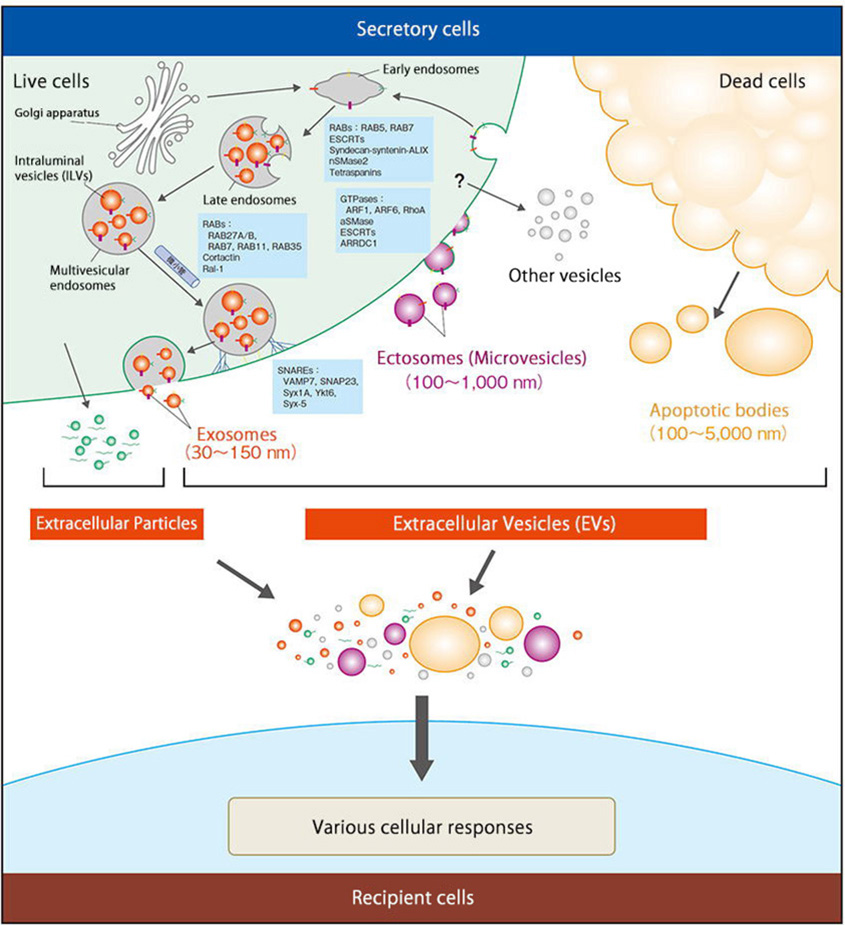Research
Exosome functions and clinical applications
A variety of cells release extracellular vesicles, including exosomes, that trigger various cellular responses (see figure below). Exosomes, small vesicles enveloped by a lipid bilayer with a diameter between 30 to 150 nm, contain membrane proteins and cytoplasmic components derived from secretory cells. As these components exhibit variability among different cell types and diseases, the collection of exosomes from bodily fluids like blood and urine holds promise as a means to identify biomarkers for early detection and prognosis of diseases.
Over the years, exosomes have been primarily regarded as a mechanism for expelling undesirable intracellular components from cells. Specifically, the process through which exosomes release proteins associated with Alzheimer's and Parkinson's diseases is implicated in the development of these conditions. Conversely, exosomes have been identified as vehicles for transferring molecules derived from secretory cells to target cells. For instance, exosomes originating from immune cells harbor antigen/MHC complexes, potentially regulating diverse immune responses, including the transfer of antigen information between immune cells and the activation/inactivation of immune cells. Additionally, recent revelations indicate the presence of mRNA and microRNA from secretory cells in exosomes, suggesting their involvement in the exchange of gene expression information between cells. While exosomes serve crucial roles as messengers in intercellular communication, research in this field is in its nascent stages, with significant advancements anticipated in the future.
Employing cutting-edge analytical methodologies, we are engaged in exploring the physiological and pathophysiological functions of exosomes, unraveling novel signaling networks. Our focus lies in comprehending the molecular mechanisms underlying exosome-mediated immune regulation, neurodegeneration, and cancer progression, with the goal of contributing to a deeper understanding of the pathogenesis of these diseases. Additionally, our objectives extend to the development of innovative preventive, diagnostic, and therapeutic approaches utilizing exosomes. This involves establishing technologies for high-purity purification, highly sensitive quantification, and functional modification of exosomes.

A variety of cells release extracellular vesicles, including exosomes, that trigger various cellular responses (see figure below). Exosomes, small vesicles enveloped by a lipid bilayer with a diameter between 30 to 150 nm, contain membrane proteins and cytoplasmic components derived from secretory cells. As these components exhibit variability among different cell types and diseases, the collection of exosomes from bodily fluids like blood and urine holds promise as a means to identify biomarkers for early detection and prognosis of diseases.
Over the years, exosomes have been primarily regarded as a mechanism for expelling undesirable intracellular components from cells. Specifically, the process through which exosomes release proteins associated with Alzheimer's and Parkinson's diseases is implicated in the development of these conditions. Conversely, exosomes have been identified as vehicles for transferring molecules derived from secretory cells to target cells. For instance, exosomes originating from immune cells harbor antigen/MHC complexes, potentially regulating diverse immune responses, including the transfer of antigen information between immune cells and the activation/inactivation of immune cells. Additionally, recent revelations indicate the presence of mRNA and microRNA from secretory cells in exosomes, suggesting their involvement in the exchange of gene expression information between cells. While exosomes serve crucial roles as messengers in intercellular communication, research in this field is in its nascent stages, with significant advancements anticipated in the future.
Employing cutting-edge analytical methodologies, we are engaged in exploring the physiological and pathophysiological functions of exosomes, unraveling novel signaling networks. Our focus lies in comprehending the molecular mechanisms underlying exosome-mediated immune regulation, neurodegeneration, and cancer progression, with the goal of contributing to a deeper understanding of the pathogenesis of these diseases. Additionally, our objectives extend to the development of innovative preventive, diagnostic, and therapeutic approaches utilizing exosomes. This involves establishing technologies for high-purity purification, highly sensitive quantification, and functional modification of exosomes.
